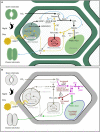CAM Models: Lessons and Implications for CAM Evolution
- PMID: 35812979
- PMCID: PMC9260309
- DOI: 10.3389/fpls.2022.893095
CAM Models: Lessons and Implications for CAM Evolution
Abstract
The evolution of Crassulacean acid metabolism (CAM) by plants has been one of the most successful strategies in response to aridity. On the onset of climate change, expanding the use of water efficient crops and engineering higher water use efficiency into C3 and C4 crops constitute a plausible solution for the problems of agriculture in hotter and drier environments. A firm understanding of CAM is thus crucial for the development of agricultural responses to climate change. Computational models on CAM can contribute significantly to this understanding. Two types of models have been used so far. Early CAM models based on ordinary differential equations (ODE) reproduced the typical diel CAM features with a minimal set of components and investigated endogenous day/night rhythmicity. This line of research brought to light the preponderant role of vacuolar malate accumulation in diel rhythms. A second wave of CAM models used flux balance analysis (FBA) to better understand the role of CO2 uptake in flux distribution. They showed that flux distributions resembling CAM metabolism emerge upon constraining CO2 uptake by the system. We discuss the evolutionary implications of this and also how CAM components from unrelated pathways could have integrated along evolution.
Keywords: CAM; CAM evolution; FBA models; ODE models; carbon concentration mechanism.
Copyright © 2022 Burgos, Miranda, Vilaprinyo, Meza-Canales and Alves.
Conflict of interest statement
The authors declare that the research was conducted in the absence of any commercial or financial relationships that could be construed as a potential conflict of interest.
Figures

Similar articles
-
Defining Mechanisms of C3 to CAM Photosynthesis Transition toward Enhancing Crop Stress Resilience.Int J Mol Sci. 2023 Aug 22;24(17):13072. doi: 10.3390/ijms241713072. Int J Mol Sci. 2023. PMID: 37685878 Free PMC article. Review.
-
A Diel Flux Balance Model Captures Interactions between Light and Dark Metabolism during Day-Night Cycles in C3 and Crassulacean Acid Metabolism Leaves.Plant Physiol. 2014 Jun;165(2):917-929. doi: 10.1104/pp.113.234468. Epub 2014 Mar 4. Plant Physiol. 2014. PMID: 24596328 Free PMC article.
-
Diel rewiring and positive selection of ancient plant proteins enabled evolution of CAM photosynthesis in Agave.BMC Genomics. 2018 Aug 6;19(1):588. doi: 10.1186/s12864-018-4964-7. BMC Genomics. 2018. PMID: 30081833 Free PMC article.
-
Engineering Crassulacean Acid Metabolism in C3 and C4 Plants.Cold Spring Harb Perspect Biol. 2024 Apr 1;16(4):a041674. doi: 10.1101/cshperspect.a041674. Cold Spring Harb Perspect Biol. 2024. PMID: 38052496 Review.
-
Metabolic Modeling of the C3-CAM Continuum Revealed the Establishment of a Starch/Sugar-Malate Cycle in CAM Evolution.Front Plant Sci. 2021 Jan 14;11:573197. doi: 10.3389/fpls.2020.573197. eCollection 2020. Front Plant Sci. 2021. PMID: 33584741 Free PMC article.
Cited by
-
Multiscale Mathematical Modeling in Systems Biology: A Framework to Boost Plant Synthetic Biology.Plants (Basel). 2025 Feb 5;14(3):470. doi: 10.3390/plants14030470. Plants (Basel). 2025. PMID: 39943032 Free PMC article. Review.
-
From leaf to multiscale models of photosynthesis: applications and challenges for crop improvement.Photosynth Res. 2024 Aug;161(1-2):21-49. doi: 10.1007/s11120-024-01083-9. Epub 2024 Apr 15. Photosynth Res. 2024. PMID: 38619700 Review.
-
Defining Mechanisms of C3 to CAM Photosynthesis Transition toward Enhancing Crop Stress Resilience.Int J Mol Sci. 2023 Aug 22;24(17):13072. doi: 10.3390/ijms241713072. Int J Mol Sci. 2023. PMID: 37685878 Free PMC article. Review.
-
Synthetic crassulacean acid metabolism (SynCAM) for improving water-use efficiency in plants.Philos Trans R Soc Lond B Biol Sci. 2025 May 29;380(1927):20240249. doi: 10.1098/rstb.2024.0249. Epub 2025 May 29. Philos Trans R Soc Lond B Biol Sci. 2025. PMID: 40439297 Review.
-
Elevated nocturnal respiratory rates in the mitochondria of CAM plants: current knowledge and unanswered questions.Ann Bot. 2023 Nov 25;132(4):855-867. doi: 10.1093/aob/mcad119. Ann Bot. 2023. PMID: 37638861 Free PMC article.
References
-
- Blasius B., Beck F., Lüttge U. (1998). Oscillatory model of crassulacean acid metabolism: structural analysis and stability boundaries with a discrete hysteresis switch. Plant Cell Environ. 21, 775–784. doi: 10.1046/j.1365-3040.1998.00312.x - DOI
-
- Blasius B., Neif R., Beck F., Lüttge U. (1999). Oscillatory model of crassulacean acid metabolism with a dynamic hysteresis switch. Proc. R. Soc. Lond. Ser. B Biol. Sci. 266, 93–101. doi: 10.1098/rspb.1999.0608 - DOI
Publication types
LinkOut - more resources
Full Text Sources
Miscellaneous

